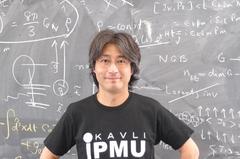Hitoshi Murayama. Bild: Kavli IPMU
Hitoshi Murayama, Japanese professor for theoretical particle and astroparticle physics and cosmology, has been awarded the prestigious Humboldt research award by the Alexander von Humboldt Society. Murayama will spend up to a year at DESY, working with his theory colleagues from DESY and the rest of Europe to enhance theoretical models for the search of dark matter.
Murayama was born in Japan in 1964 and spent a few years of his childhood in Germany. After gaining his PhD in theoretical physics from the University of Tokyo he moved to Lawrence Berkeley National Laboratory in California, US, becoming a professor at the University of California at Berkeley later. He is also Director of the Kavli Institute for the Physics and Mathematics of the Universe and Deputy Director for the Linear Collider Collaboration, the international group planning a future particle collider.
“We are delighted to deepen DESY’s already close collaboration with Hitoshi Murayama even further thanks to the Humboldt Foundation. Hitoshi is an internationally renowned theorist with many visionary ideas and I am sure he will enrich research at DESY enormously thanks to his substantial international experience and inspiring personality,” says Joachim Mnich, Director for Particle and Astroparticle Physics at DESY.
Murayama is currently working on a model that could explain the mysterious and as yet undiscovered dark matter. The most commonly accepted theory to explain dark matter is that it consists of elementary particles that hardy interact with other particles. Murayama is developing a theory postulating that dark matter may consist of composite rather than elementary particles.
„If you look at the rotation curve and mass distribution of dwarf galaxies there are indications that there’s more going on in the galaxy’s centre than we thought. That could be strongly interacting massive particles (SIMPs) consisting of dark quarks and gluons,“ Murayama explains. He will use his time in Hamburg to check this theory against existing data and deepen the collaboration with theory colleagues working on future projects like the International Linear Collider. The proposed particles could be found at accelerators with a high collision rate and low-background collisions like the SuperKEKB accelerator just starting up and the linear collider.
The Humboldt Research Award is granted in recognition of a researcher's entire achievements to date to academics from abroad whose fundamental discoveries, new theories or insights have had a significant impact on their own discipline and who are expected to continue producing cutting-edge achievements in the future.
Award winners are invited to spend a period of up to one year to carry out a self-chosen research project in cooperation with specialist colleagues at a research institution in Germany.








